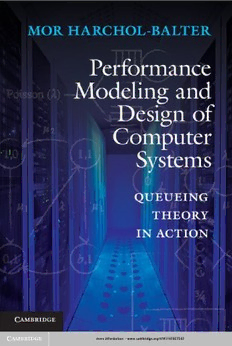
Performance modeling and design of computer systems: queueing theory in action PDF
Preview Performance modeling and design of computer systems: queueing theory in action
more information - www.cambridge.org/9781107027503 PerformanceModelingandDesignofComputerSystems Computersystemsdesignisfullofconundrums: (cid:2) Given a choice between a single machine with speed s, or n machines each with speeds/n,whichshouldwechoose? (cid:2) Ifboththearrivalrateandserviceratedouble,willthemeanresponsetimestaythe same? (cid:2) Shouldsystemsreallyaimtobalanceload,oristhisaconvenientmyth? (cid:2) Ifaschedulingpolicyfavorsonesetofjobs,doesitnecessarilyhurtsomeotherjobs, orarethese“conservationlaws”beingmisinterpreted? (cid:2) Dogreedy,shortest-delay,routingstrategiesmakesenseinaserverfarm,oriswhat isgoodfortheindividualdisastrousforthesystemasawhole? (cid:2) How do high job size variability and heavy-tailed workloads affect the choice of a schedulingpolicy? (cid:2) Howshouldonetradeoffenergyanddelayindesigningacomputersystem? (cid:2) If12serversareneededtomeetdelayguaranteeswhenthearrivalrateis9jobs/sec, willweneed12,000serverswhenthearrivalrateis9,000jobs/sec? Tacklingthequestionsthatsystemsdesignerscareabout,thisbookbringsqueueingtheory decisively back to computer science. The book is written with computer scientists and engineersinmindandisfullofexamplesfromcomputersystems,aswellasmanufacturing and operations research. Fun and readable, the book is highly approachable, even for undergraduates,whilestillbeingthoroughlyrigorousandalsocoveringamuchwiderspan oftopicsthanmanyqueueingbooks. Readersbenefitfromalivelymixofmotivationandintuition,withillustrations,examples, and more than 300 exercises – all while acquiring the skills needed to model, analyze, anddesignlarge-scalesystemswithgoodperformanceandlowcost.Theexercisesarean importantfeature,teachingresearch-levelcounterintuitivelessonsinthedesignofcomputer systems. The goal is to train readers not only to customize existing analyses but also to inventtheirown. Mor Harchol-Balter is an Associate Professor in the Computer Science Department at CarnegieMellonUniversity.SheisaleaderintheACMSigmetricsConferenceonMeasure- mentandModelingofComputerSystems,havingservedastechnicalprogramcommittee chairin2007andconferencechairin2013. Performance Modeling and Design of Computer Systems Queueing Theory in Action Mor Harchol-Balter Carnegie Mellon University, Pennsylvania cambridgeuniversitypress Cambridge,NewYork,Melbourne,Madrid,CapeTown, Singapore,Sa˜oPaulo,Delhi,MexicoCity CambridgeUniversityPress 32AvenueoftheAmericas,NewYork,NY10013-2473,USA www.cambridge.org Informationonthistitle:www.cambridge.org/9781107027503 (cid:2)C MorHarchol-Balter2013 Thispublicationisincopyright.Subjecttostatutoryexception andtotheprovisionsofrelevantcollectivelicensingagreements, noreproductionofanypartmaytakeplacewithoutthewritten permissionofCambridgeUniversityPress. Firstpublished2013 PrintedintheUnitedStatesofAmerica AcatalogrecordforthispublicationisavailablefromtheBritishLibrary. LibraryofCongressCataloginginPublicationData Harchol-Balter,Mor,1966– Performancemodelinganddesignofcomputersystems:queueingtheoryin action/MorHarchol-Balter. pagescm Includesbibliographicalreferencesandindex. ISBN978-1-107-02750-3 1.Transactionsystems(Computersystems)–Mathematicalmodels. 2.Computer systems–Designandconstruction–Mathematics. 3.Queueingtheory. 4.Queueingnetworks(Datatransmission) I.Title. QA76.545.H37 2013 519.8(cid:2)2–dc23 2012019844 ISBN978-1-107-02750-3Hardback CambridgeUniversityPresshasnoresponsibilityforthepersistenceoraccuracyof URLsforexternalorthird-partyInternetwebsitesreferredtointhispublicationand doesnotguaranteethatanycontentonsuchwebsitesis,orwillremain,accurateor appropriate. TomylovinghusbandAndrew,myawesomesonDanny, andmyparents,IritandMicha Ihavealwaysbeeninterestedinfindingbetterdesignsforcomputersystems,designs thatimproveperformancewithoutthepurchaseofadditionalresources.WhenIlook backattheproblemsthatIhavesolvedandIlookaheadtotheproblemsIhopeto solve,Irealizethattheproblemformulationskeepgettingsimplerandsimpler,andmy footinglesssecure.EverywisdomthatIoncebelieved,Ihavenowcometoquestion: Ifaschedulingpolicyhelpsonesetofjobs,doesitnecessarilyhurtsomeotherjobs, orarethese“conservationlaws”beingmisinterpreted?Dogreedyroutingstrategies makesenseinserverfarms,oriswhatisgoodfortheindividualactuallydisastrousfor thesystemasawhole?Whencomparingasinglefastmachinewithnslowmachines, eachof1/nththespeed,thesinglefastmachineistypicallymuchmoreexpensive–but doesthatmeanthatitisnecessarilybetter?Shoulddistributedsystemsreallyaimto balanceload,oristhisaconvenientmyth?Cyclestealing,wheremachinescanhelp eachotherwhentheyareidle,soundslikeagreatidea,butcanwequantifytheactual benefit?Howmuchistheperformanceofschedulingpoliciesaffectedbyvariability inthearrivalrateandservicerateandbyfluctuationsintheload,andwhatcanwedo tocombatvariability?Inherentinthesequestionsistheimpactofrealuserbehaviors and real-world workloads with heavy-tailed, highly variable service demands, as well as correlated arrival processes. Also intertwined in my work are the tensions betweentheoreticalanalysisandtherealitiesofimplementation,eachmotivatingthe other. In my search to discover new research techniques that allow me to answer theseandotherquestions,IfindthatIamconvergingtowardthefundamentalcore thatdefinesalltheseproblems,andthatmakesthecounterintuitivemorebelievable. Contents Preface xvii Acknowledgments xxiii I IntroductiontoQueueing 1 MotivatingExamplesofthePowerofAnalyticalModeling 3 1.1 WhatIsQueueingTheory? 3 1.2 ExamplesofthePowerofQueueingTheory 5 2 QueueingTheoryTerminology 13 2.1 WhereWeAreHeading 13 2.2 TheSingle-ServerNetwork 13 2.3 ClassificationofQueueingNetworks 16 2.4 OpenNetworks 16 2.5 MoreMetrics:ThroughputandUtilization 17 2.6 ClosedNetworks 20 2.6.1 Interactive(Terminal-Driven)Systems 21 2.6.2 BatchSystems 22 2.6.3 ThroughputinaClosedSystem 23 2.7 DifferencesbetweenClosedandOpenNetworks 24 2.7.1 AQuestiononModeling 25 2.8 RelatedReadings 25 2.9 Exercises 26 II NecessaryProbabilityBackground 3 ProbabilityReview 31 3.1 SampleSpaceandEvents 31 3.2 ProbabilityDefinedonEvents 32 3.3 ConditionalProbabilitiesonEvents 33 3.4 IndependentEventsandConditionallyIndependentEvents 34 3.5 LawofTotalProbability 35 3.6 BayesLaw 36 3.7 DiscreteversusContinuousRandomVariables 37 3.8 ProbabilitiesandDensities 38 3.8.1 Discrete:ProbabilityMassFunction 38 3.8.2 Continuous:ProbabilityDensityFunction 41 3.9 ExpectationandVariance 44 3.10 JointProbabilitiesandIndependence 47 vii viii contents 3.11 ConditionalProbabilitiesandExpectations 49 3.12 ProbabilitiesandExpectationsviaConditioning 53 3.13 LinearityofExpectation 54 3.14 NormalDistribution 57 3.14.1 LinearTransformationProperty 58 3.14.2 CentralLimitTheorem 61 3.15 SumofaRandomNumberofRandomVariables 62 3.16 Exercises 64 4 GeneratingRandomVariablesforSimulation 70 4.1 Inverse-TransformMethod 70 4.1.1 TheContinuousCase 70 4.1.2 TheDiscreteCase 72 4.2 Accept-RejectMethod 72 4.2.1 DiscreteCase 73 4.2.2 ContinuousCase 75 4.2.3 SomeHarderProblems 77 4.3 Readings 78 4.4 Exercises 78 5 SamplePaths,Convergence,andAverages 79 5.1 Convergence 79 5.2 StrongandWeakLawsofLargeNumbers 83 5.3 TimeAverageversusEnsembleAverage 84 5.3.1 Motivation 85 5.3.2 Definition 86 5.3.3 Interpretation 86 5.3.4 Equivalence 88 5.3.5 Simulation 90 5.3.6 AverageTimeinSystem 90 5.4 RelatedReadings 91 5.5 Exercise 91 III ThePredictivePowerofSimpleOperationalLaws:“What-If” QuestionsandAnswers 6 Little’sLawandOtherOperationalLaws 95 6.1 Little’sLawforOpenSystems 95 6.2 Intuitions 96 6.3 Little’sLawforClosedSystems 96 6.4 ProofofLittle’sLawforOpenSystems 97 6.4.1 StatementviaTimeAverages 97 6.4.2 Proof 98 6.4.3 Corollaries 100 6.5 ProofofLittle’sLawforClosedSystems 101 6.5.1 StatementviaTimeAverages 101 6.5.2 Proof 102 6.6 GeneralizedLittle’sLaw 102
